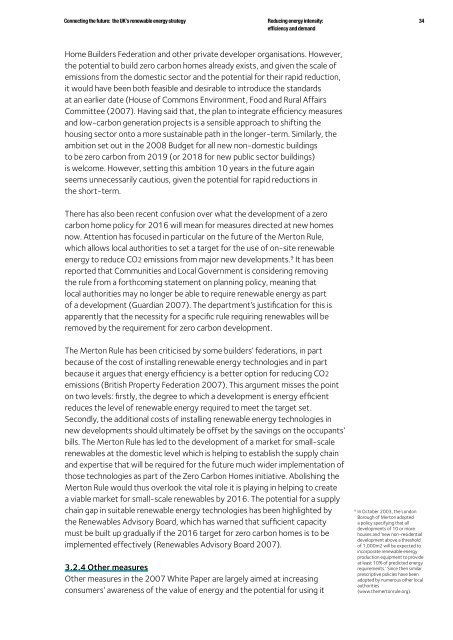Connecting the Future - Greenpeace UK
Connecting the Future - Greenpeace UK
Connecting the Future - Greenpeace UK
You also want an ePaper? Increase the reach of your titles
YUMPU automatically turns print PDFs into web optimized ePapers that Google loves.
<strong>Connecting</strong> <strong>the</strong> future: <strong>the</strong> <strong>UK</strong>’s renewable energy strategy<br />
Reducing energy intensity:<br />
efficiency and demand<br />
34<br />
Home Builders Federation and o<strong>the</strong>r private developer organisations. However,<br />
<strong>the</strong> potential to build zero carbon homes already exists, and given <strong>the</strong> scale of<br />
emissions from <strong>the</strong> domestic sector and <strong>the</strong> potential for <strong>the</strong>ir rapid reduction,<br />
it would have been both feasible and desirable to introduce <strong>the</strong> standards<br />
at an earlier date (House of Commons Environment, Food and Rural Affairs<br />
Committee (2007). Having said that, <strong>the</strong> plan to integrate efficiency measures<br />
and low-carbon generation projects is a sensible approach to shifting <strong>the</strong><br />
housing sector onto a more sustainable path in <strong>the</strong> longer-term. Similarly, <strong>the</strong><br />
ambition set out in <strong>the</strong> 2008 Budget for all new non-domestic buildings<br />
to be zero carbon from 2019 (or 2018 for new public sector buildings)<br />
is welcome. However, setting this ambition 10 years in <strong>the</strong> future again<br />
seems unnecessarily cautious, given <strong>the</strong> potential for rapid reductions in<br />
<strong>the</strong> short-term.<br />
There has also been recent confusion over what <strong>the</strong> development of a zero<br />
carbon home policy for 2016 will mean for measures directed at new homes<br />
now. Attention has focused in particular on <strong>the</strong> future of <strong>the</strong> Merton Rule,<br />
which allows local authorities to set a target for <strong>the</strong> use of on-site renewable<br />
energy to reduce CO2 emissions from major new developments. 9 It has been<br />
reported that Communities and Local Government is considering removing<br />
<strong>the</strong> rule from a forthcoming statement on planning policy, meaning that<br />
local authorities may no longer be able to require renewable energy as part<br />
of a development (Guardian 2007). The department’s justification for this is<br />
apparently that <strong>the</strong> necessity for a specific rule requiring renewables will be<br />
removed by <strong>the</strong> requirement for zero carbon development.<br />
The Merton Rule has been criticised by some builders’ federations, in part<br />
because of <strong>the</strong> cost of installing renewable energy technologies and in part<br />
because it argues that energy efficiency is a better option for reducing CO2<br />
emissions (British Property Federation 2007). This argument misses <strong>the</strong> point<br />
on two levels: firstly, <strong>the</strong> degree to which a development is energy efficient<br />
reduces <strong>the</strong> level of renewable energy required to meet <strong>the</strong> target set.<br />
Secondly, <strong>the</strong> additional costs of installing renewable energy technologies in<br />
new developments should ultimately be offset by <strong>the</strong> savings on <strong>the</strong> occupants’<br />
bills. The Merton Rule has led to <strong>the</strong> development of a market for small-scale<br />
renewables at <strong>the</strong> domestic level which is helping to establish <strong>the</strong> supply chain<br />
and expertise that will be required for <strong>the</strong> future much wider implementation of<br />
those technologies as part of <strong>the</strong> Zero Carbon Homes initiative. Abolishing <strong>the</strong><br />
Merton Rule would thus overlook <strong>the</strong> vital role it is playing in helping to create<br />
a viable market for small-scale renewables by 2016. The potential for a supply<br />
chain gap in suitable renewable energy technologies has been highlighted by<br />
<strong>the</strong> Renewables Advisory Board, which has warned that sufficient capacity<br />
must be built up gradually if <strong>the</strong> 2016 target for zero carbon homes is to be<br />
implemented effectively (Renewables Advisory Board 2007).<br />
3.2.4 O<strong>the</strong>r measures<br />
O<strong>the</strong>r measures in <strong>the</strong> 2007 White Paper are largely aimed at increasing<br />
consumers’ awareness of <strong>the</strong> value of energy and <strong>the</strong> potential for using it<br />
9 <br />
In October 2003, <strong>the</strong> London<br />
Borough of Merton adopted<br />
a policy specifying that all<br />
developments of 10 or more<br />
houses and ‘new non-residential<br />
development above a threshold<br />
of 1,000m2 will be expected to<br />
incorporate renewable energy<br />
production equipment to provide<br />
at least 10% of predicted energy<br />
requirements.’ Since <strong>the</strong>n similar<br />
prescriptive policies have been<br />
adopted by numerous o<strong>the</strong>r local<br />
authorities<br />
(www.<strong>the</strong>mertonrule.org).




![[2007] EWHC 311 - Greenpeace UK](https://img.yumpu.com/22079793/1/184x260/2007-ewhc-311-greenpeace-uk.jpg?quality=85)











